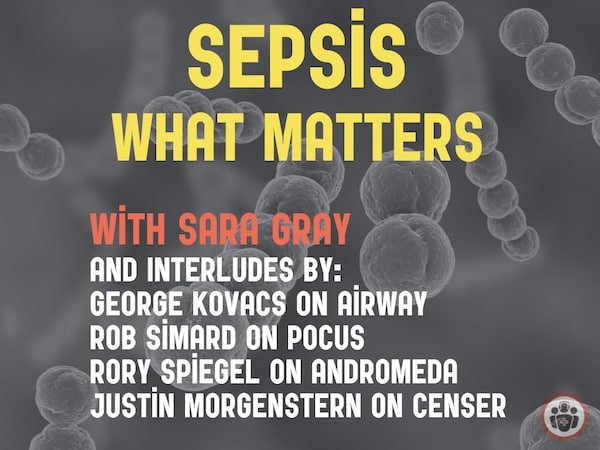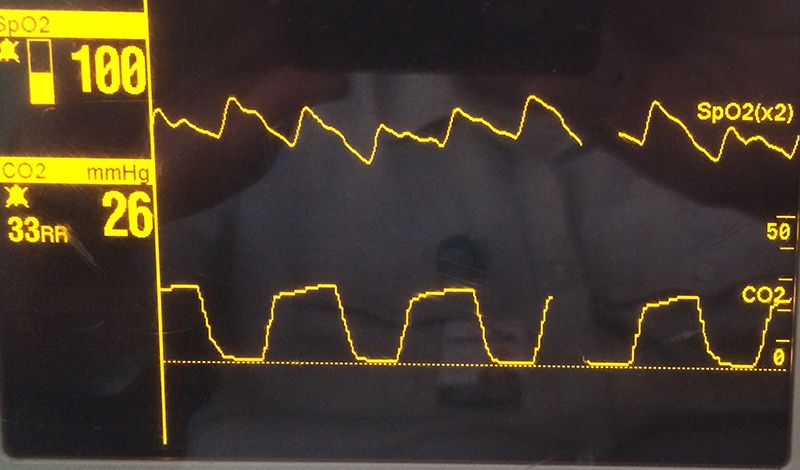low end tidal co2 sepsis
There are Capnometers which display a numeric reading of the CO2 Waveform Capnography which creates a graph of the CO2 as well as certain aspects about how the patient is breathing and. This was a prospective diagnostic study set in a British acute medical admissions ward.

The State Of Sepsis With Dr Karin Molander Sepsis Alliance Chair Elect Jvion
Riaz I Jacob B Pulmonary embolism in Bradford UK.

. On the other hand a high CO2 reading may indicate airway narrowing airway obstruction or respiratory distress. Polito CC Isakov A Yancey AH 2nd et al. In critical care End Tidal CO2 monitoring is used to assess adequacy of circulation to the lungs which provides clues about circulation to the rest of the body.
Prehospital identification and initiation of therapy for severe sepsis may. On the other hand a high CO2 reading may indicate airway narrowing. Below normal end-tidal carbon dioxide measurement ETCO2 is associated with worse outcomes in sepsis and trauma patients as compared to patients with normal ETCO2.
Theres a piece in the Orlando Sentinel about etco2 as a trigger for sepsis alerts. Capnograph is an indispensable tool for monitoring metabolic and respiratory function. To determine the utility of a prehospital sepsis screening protocol utilizing systemic inflammatory response syndrome SIRS criteria and end-tidal carbon dioxide ETCO2.
End-tidal carbon dioxide is associated with lactate levels and mortality in emergency department patients with suspected sepsis. To evaluate whether EtCO2 measurement can be used at the bedside to exclude pulmonary embolism PE. These waste products then accumulate in.
A low end-tidal CO2 may indicate poor perfusion hypovolemia or sepsis. Cecal ligation and puncture CLP was used to cause severe sepsis in male SpragueDawley rats. Additionally low end-tidal carbon dioxide ETCO 2 levels have been associated with lactic acidosis organ dysfunction and mortality in ED patients with suspected sepsis.
Therefore EtCO2 might. Low EtCO 2 with other signs of shock indicates poor systemic perfusion which can be caused by hypovolemia sepsis or dysrhythmias. In this study the aim was to review the applications of end-tidal carbon dioxide ETCO2 monitoring in emergency department multiple databases were comprehensively searched with combination of following keywords.
Search titles only By. Development and validation of a novel EMS screening tool. Sepsis leads to metabolic acidosis through an excess production of lactate and end organ damage tachypnea and increased dead space.
In fact its commonly called the ventilation vital sign. 2014 Apr14 2 Objective. If a patient has a high CO2 reading on the CO2 monitoring.
Quantitative waveform capnography can be a reliable surrogate for lactate monitoring in detecting metabolic distress in sepsis patients. End Tidal CO2 monitoring is essential as it is the fastest indicator of ventilatory compromise. Sham n 5 CLP n 10 end-tidal carbon dioxide ETCO 2 n 10 and mean arterial pressure MAP n 10In ETCO 2 group fluid resuscitation FR began when ETCO 2 at most 25 mmHg.
A prehospital screening tool utilizing end-tidal carbon dioxide predicts sepsis and severe sepsis. PaCO2 is affected by hyperventilation rapid or deep breathing hypoventilation slow or shallow breathing and acid-base status. ETCO2 emergency department monitoring and critical.
Prehospital recognition of severe sepsis. Although oxygenation and ventilation can be assessed non-invasively via pulse oximetry and end-tidal carbon dioxide monitoring respectively ABG analysis is the standard. A low end-tidal CO2 may indicate poor perfusion hypovolemia or sepsis.
Am J Emerg Med. The single center study was a prospective observational cohort study evaluating end-tidal carbon dioxide as a resuscitative end point for sepsis 8. Sepsis is a worldwide public health issue.
In MAP group FR began when MAP at most 100 mmHg. New posts Search forums. We conducted a prospective cohort study among sepsis alerts activated by emergency medical services during a 12 month period after the initiation of a new sepsis screening protocol.
End-tidal carbon dioxide ETco 2 monitoring provides valuable information about CO 2 production and clearance ventilation. Am J Emerg Med 2016. Why do we measure end tidal CO2.
Role of end-tidal CO2 as a screening tool Clin Med. Hunter CL Silvestri S Ralls G Stone A Walker A Papa L. There are four groups in this study.
New posts New. Although the normal range for CO2 should be between 35-45mmHg CO2 monitoring gives healthcare providers a lot more insight into what is going on with a patients condition. End tidal CO2 revealing a substantially low CO2 measurement also suggests hypocapnia eg etCO2.
More Than Just a Number. We sought to determine if ETCO2 can be used in the prehospital setting to predict transfusion requirement operative hemorrhage control or mortality in the first 24 h. Therefore correlation between the end tidal CO2 and an ABGVBG measurement is needed to confirm the diagnosis of hypocapnia.
Why is CO2 high in. Low EtCO2 with other signs of shock indicates poor systemic perfusion which can be caused by hypovolemia sepsis or dysrhythmias. Hunter CL Silvestri S Dean M et al.
Also called capnometry or capnography this noninvasive technique provides a breath-by-breath analysis and a continuous recording of ventilatory status. End tidal CO2 for sepsis alert. Therefore patients with severe sepsis may have an elevated respiratory rate with a low end-tidal CO2 reading.
Start date May 8. These processes decrease the end tidal CO2 EtCO2 pressure because they decrease PaCO2 decrease exhalation time and reduce the available alveoli to excrete CO2 respectively. Discover the key facts in understanding this technology and its implications in clinical practice.
However this may also be caused by pulmonary dysfunction with an increase in dead space volume. End-Tidal CO2 monitors do exactly as the name implies they monitor CO2 in the air that we breathe out. There is more than one version of this tool.
It can also help the healthcare provider determine if the patient is being ventilated adequately.

Exhaled End Tidal Carbon Dioxide As A Predictor Of Lactate And Pediatric Sepsis The American Journal Of Emergency Medicine

Sepsis And Septic Shock Emergency Medicine Cases Em Cases Podcast

Evidence Supports Using End Tidal Carbon Dioxide To Detect Prehospital Sepsis Jems Ems Emergency Medical Services Training Paramedic Emt News

6 Useful Sepsis Assessment And Treatment Tips Capnoacademy Capnoacademy

C Roc Curves For Predicting Severe Sepsis Auroc Area Under Receiver Download Scientific Diagram

Use End Tidal Carbon Dioxide To Diagnose Sepsis Jems Ems Emergency Medical Services Training Paramedic Emt News

Two Hours Of In Vivo Lung Perfusion Improves Lung Function In Sepsis Induced Acute Respiratory Distress Syndrome Seminars In Thoracic And Cardiovascular Surgery

Vasopressors Demystified An Overview Of The Physiology Of Vasopressors Including When To Start When To Use Periphera Icu Nursing Icu Icu Nurse Critical Care

Caep Sepsis Treatment Checklist Download Table

End Tidal Carbon Dioxide Is Associated With Mortality And Lactate In Patients With Suspected Sepsis The American Journal Of Emergency Medicine

Sepsis Early Recognition And Treatment In Prehospital Setting Vital For Patient Outcomes Jems Ems Emergency Medical Services Training Paramedic Emt News

Jems Using Etco2 To Detect Sepsis Youtube

Evidence Supports Using End Tidal Carbon Dioxide To Detect Prehospital Sepsis Jems Ems Emergency Medical Services Training Paramedic Emt News

Pin On Educational Medical Diagrams

How Capnography Can Be Used To Identify Sepsis

Sepsis Management For The Nephrologist American Society Of Nephrology

